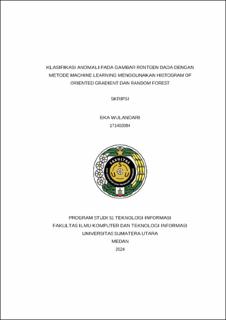Klasifikasi Anomali pada Gambar Rontgen Dada dengan Metode Machine Learning Menggunakan Histogram of Oriented Gradient dan Random Forest
Anomaly Classification in Chest X-Ray Images Using Machine Learning Method with Histogram of Oriented Gradient and Random Forest

Date
2024Author
Wulandari, Eka
Advisor(s)
Zendrato, Niskarto
Andayani, Ulfi
Metadata
Show full item recordAbstract
Before confirming that there is an abnormal condition, doctors use radiological
examinations as the first step in diagnosing lung disease. To classify unusual
conditions, an examination is carried out via a chest x-ray. Therefore, this study aims
to build a model for classifying abnormal objects using the Histogram of Oriented
Gradient (HOG) and Random Forest (RF) algorithms on chest x-ray images, where
there will be 12 abnormal objects to be classified. Among them are: Atelectasis,
Cardiomegaly, Concolidation, Infiltration, Nodule, Mass, Emphysema, Fibrosis,
Pleural Effusion, Pneumothorax, Pneumonia and No_Finding. There are several
techniques used to improve model accuracy when building a training model, namely
sqrt and log2. The best accuracy results have been obtained from the Random Forest
model by training using an n-estimator of 100 and the max features sqrt is 92%, with
these results it can be concluded that the Histogram of Oriented Gradient and
Random forest methods used in this study can classify X-ray results properly. In
addition to building the model, the authors also developed a desktop-based
application that aims to assist general practitioners in facilitating the process of
diagnosing disease by analyzing lung results. This application uses image processing
technology to classify signs of disease seen on X-ray images of the lungs. This
desktop-based application is expected to help doctors or related health workers to
simplify the process of disease diagnosis and can be utilized as a good and useful
learning tool.
Collections
- Undergraduate Theses [767]
